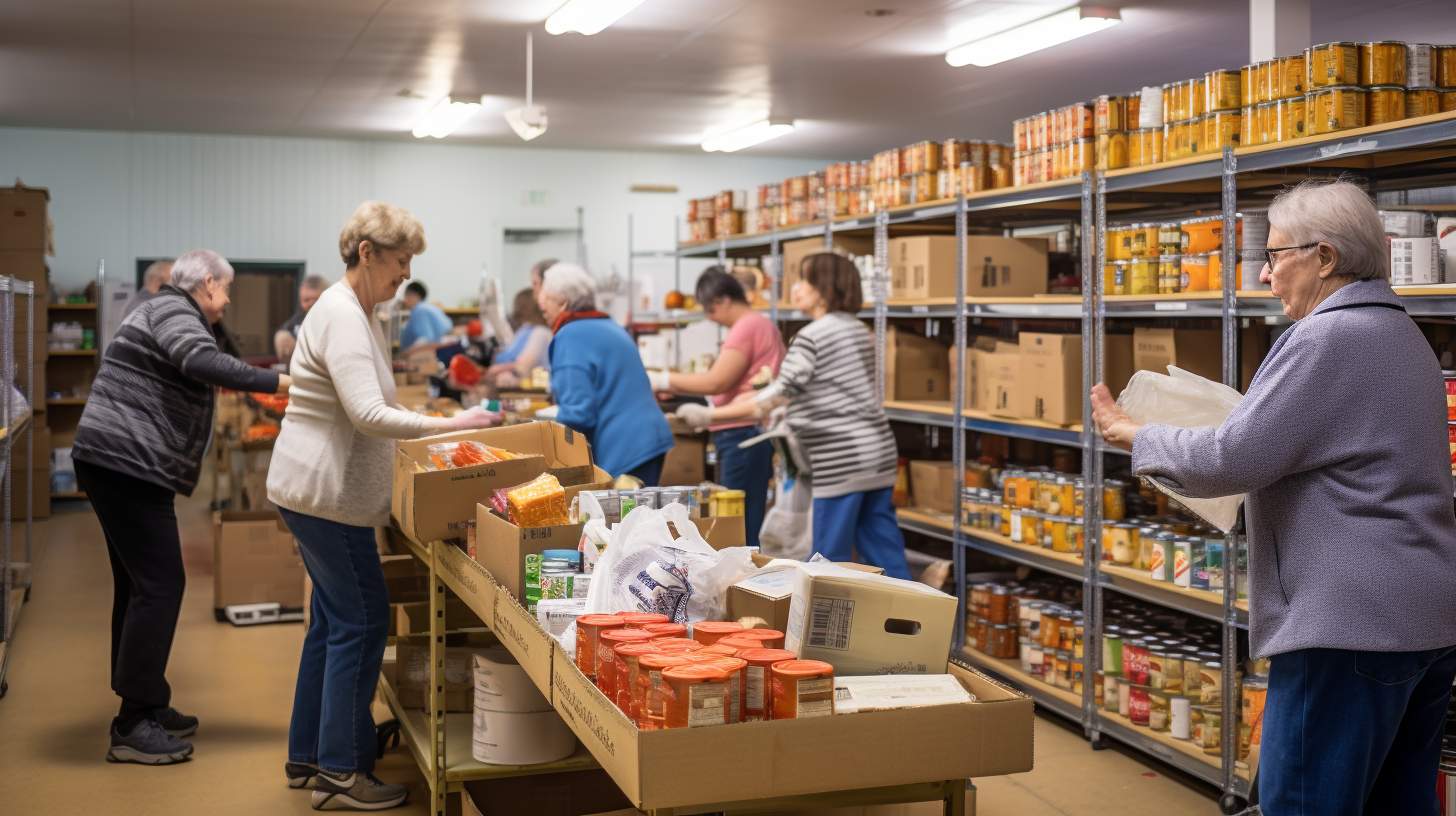Start a Food Pantry & Community Bank: Getting Started Guide for Your Community
Imagine a community where no one goes to bed hungry, where food is readily available for those in need. This was the vision that sparked my journey into starting a food pantry. Growing up, I witnessed firsthand the struggles faced by families who couldn’t afford basic necessities, including enough food on their tables. It was disheartening to see people in my own neighborhood battling hunger every day. That’s when I realized the importance of food pantries in addressing this pressing issue.
Starting a community food pantry can have a profound impact on your community. By providing access to essential food supplies and nutritious meals, you can make a tangible difference in the lives of individuals and families facing hunger. Whether it’s distributing boxed food items or partnering with local food banks and shelves, your efforts can help alleviate the burden of hunger and ensure that no one goes without a meal.
So if you’re ready to take action and make a positive change, join me as we explore how to start a food pantry and address the urgent needs of our communities.
Essential Insights for Establishing a Food Pantry in the Community
- Assess Your Motivation and Resources: Before starting a food pantry, evaluate your motivation, available time and finances, and the actual need in your community. Ensure that you are genuinely committed to helping those in need.
- Create a Clear Mission Statement: develop a mission statement that defines the purpose of your food pantry, identifies the target population, and outlines core values and services provided.
- Set Goals and Objectives: Clearly define your long-term goals, specific objectives, and strategies for achieving them. This will help keep your pantry focused on its mission and track progress.
- Understand Legal Aspects: Familiarize yourself with local regulations, obtain necessary permits, address liability issues related to handling and distributing food donations, and explore tax-exempt status options such as becoming a
nonprofit organization. - Overcome Challenges: Identify potential challenges, seek support from local organizations, utilize online resources, and actively engage with the community to overcome obstacles and ensure the success of your food pantry.
Essential Questions for Assessing Food Pantry Readiness

Before delving into launching a food pantry, ensure you’re truly committed. Ask yourself key questions to gauge your motivation, available resources, and the community’s need.
Evaluate Your Drive
Starting a food pantry demands dedication. Assess your motivation – is it fueled by a genuine desire to help? Do personal connections drive your commitment? Understanding these factors keeps you focused.
Check Your Resources
Success hinges on time and finances. Evaluate your commitment – how much time can you invest regularly? Can you allocate funds for setup, operational costs, and food supplies? Realistic resource assessment ensures effective planning.
Assess Community Need
Research the need for a food pantry in your area. Gather data on poverty and unemployment rates. Connect with local organizations, social workers, and community leaders for insights into prevalent hunger issues.
Here are some additional questions to guide your assessment:
-
How many individuals or families struggle with food insecurity?
-
Are there any specific demographics that are disproportionately affected?
-
Are there any existing food pantries or soup kitchens in the area? If so, do they adequately meet the demand?
-
Is there an increase in demand during certain times of the year?
Research and engaging with stakeholders will reveal if a food pantry is needed in your community. Starting one isn’t a light decision; carefully consider your motivations, resources, and community need to lay a solid foundation for success.
Planning Your Food Pantry: Creating a Solid Business Plan

Crafting a successful food pantry requires a solid plan. Develop a concise mission statement that articulates your purpose and target audience. Outline goals, objectives, and establish an organizational structure with defined volunteer roles and responsibilities.
When crafting your mission statement, consider the following:
-
Target population: Identify the specific community or demographic you want to support with your food pantry.
-
Core values: Determine the principles and beliefs that will shape how you operate your pantry.
-
Services provided: Outline the types of assistance you will offer, such as distributing food boxes or providing nutritional education.
A concise mission statement communicates your pantry’s purpose to donors, volunteers, and the community. Set clear goals and measurable objectives to stay focused on your mission. Here’s how you can approach this:
-
Identify goals: Determine what outcomes you want to accomplish with your food pantry. For example, increasing access to nutritious food in underserved areas.
-
Set objectives: Break down each goal into specific targets that are achievable within a certain timeframe. For instance, distributing 100 food boxes per week.
-
Develop strategies: Create action plans detailing how you will meet each objective. This could involve partnering with local farmers for fresh produce or organizing fundraising events.
Clear goals and strategies offer focus and enable effective progress tracking. Establish an organized structure for your food pantry by defining roles and responsibilities for volunteers, ensuring smooth operations. Here’s how you can establish this structure:
-
Identify key positions: Determine the essential roles needed in your food pantry, such as a director, volunteer coordinator, or inventory manager.
-
Assign responsibilities: Clearly define what each role entails and the specific tasks associated with it. For example, the volunteer coordinator may be responsible for recruiting and training volunteers.
-
Promote teamwork: Encourage collaboration among your volunteers by emphasizing the importance of working together toward a common goal.
By creating an organized structure with clearly defined roles, you can streamline operations and ensure that all aspects of your food pantry are effectively managed.
Remember, planning is crucial when starting a food pantry. Developing a mission statement, outlining goals and objectives, and establishing an organizational structure will set a solid foundation for success.
Legal Aspects of Starting a Food Pantry

Launching a food pantry involves legal considerations crucial for compliance. Prioritize these key aspects:
1. Local Regulations and Permits:
– Research and comply with area-specific regulations.
– Obtain necessary licenses from health departments.
– Adhere to zoning restrictions and safety guidelines.
2. Liability Concerns with Donated Food:
– Regularly inspect and ensure the safety of donated items.
– Implement clear policies on expiration dates and handling procedures.
– Educate volunteers to minimize risks of accidents or contamination.
3. Tax-Exempt Status for Impact:
– Explore tax-exempt options, like nonprofit status.
– Enjoy benefits such as tax-deductible donations and eligibility for grants.
– Enhance credibility and transparency for donor confidence.
Consult legal professionals or nonprofit experts to navigate the process effectively.
Overcoming Challenges: First Steps and Resources

Starting a food pantry has challenges, but with the right approach, you can make a positive impact. Here are key steps and resources:
Identify Challenges:
-
Lack of funds
-
Limited space
-
Navigating legal requirements
Seek Local Support:
-
Connect with food banks for donation and distribution guidance.
-
Explore faith-based organizations with established outreach programs.
-
Engage community centers for valuable insights.
Utilize Online Resources:
-
Join food pantry forums for advice and shared experiences.
-
Access toolkits covering fundraising, volunteer recruitment, and legal compliance.
-
Explore mentorship programs offering one-on-one support.
By leveraging these resources, you’ll gain valuable insights, learn best practices, and overcome challenges effectively.
Building a Sustainable Food Pantry: Addressing Challenges

Optimize Inventory Management:
Implement efficient systems to minimize waste and ensure food freshness.
– Categorize items for easy access.
– Adopt a First-in, First-out (FIFO) system.
– Conduct regular stock checks to discard expired items.
Forge Local Partnerships:
Build sustainable relationships with businesses, farms, or grocery stores for regular food donations.
– Identify aligned partners.
– Establish logistics for safe and regular donations.
Secure Financial Stability:
Explore grants and fundraising for long-term success.
– Research available grants targeting food insecurity.
– Develop a comprehensive fundraising plan.
– Engage volunteers in fundraising activities for wider impact.
By implementing these strategies, you ensure a well-managed pantry, a consistent food supply, and financial stability for continued community support.
Tips for Organizing and Operating a Food Pantry Program

Efficient Food Pantry Operations:
Organizing a successful food pantry involves key considerations for efficiency, hygiene, and inclusivity.
Streamline Processes:
– Receiving: Set up a designated drop-off area with clear guidelines.
– Sorting: Train volunteers to categorize items for easy access.
– Storing: Maintain proper storage conditions, check expiration dates regularly.
– Distributing: Implement organized systems to minimize waste and hoarding.
Train Volunteers Effectively:
– Provide food safety training, emphasizing handwashing and cross-contamination prevention.
– Teach labeling and dating to prioritize the use of older items first.
– Emphasize cleanliness for a hygienic pantry space.
Prioritize Client Dignity and Confidentiality:
– Establish confidentiality policies and train volunteers accordingly.
– Design a dignified distribution process, considering choice-based systems.
– Collaborate for additional support services beyond food, such as nutrition education or access to social workers.
By following these streamlined tips, you can run an efficient and respectful food pantry program that serves the community effectively.
Promotion and Advertisement of Your Food Pantry

Boost Your Food Pantry’s Reach:
Ensure your food pantry’s success by effective promotion. Use these streamlined tips:
1. Leverage Social Media:
– Create accounts on platforms like Facebook, Instagram, and Twitter.
– Regularly post updates, events, and success stories.
– Encourage followers to share for wider outreach.
2. Partner with Local Media:
– Reach out to local newspapers, radio, or TV stations for coverage.
– Offer stories or interviews to raise awareness and build credibility.
3. Eye-catching Physical Promotion:
– Design visually appealing flyers or brochures.
– Distribute in community spaces, churches, schools, and supermarkets.
4. Collaborate with Businesses:
– Approach local stores for donation box placement or regular food contributions.
– Acknowledge support through social media or other promotional means.
5. Host Engaging Fundraising Events:
– Organize events like food drives, bake sales, or charity runs.
– Promote through various channels for community engagement.
6. Community Engagement:
– Attend local events and meetings to network.
– Establish partnerships with like-minded organizations for mutual support.
Effective promotion is key to attracting support for your food pantry. Use social media, local media partnerships, physical materials, business collaborations, fundraising events, and community engagement to make a significant impact in your community.
Taking the Next Steps
Congratulations on completing all the sections before this conclusion! You’ve gained valuable insights into starting and running a successful food pantry. Now, it’s time to take the next steps towards making your vision a reality.
First, revisit the key questions you asked yourself in the “Assessing Readiness” section. Reflect on your answers and make any necessary adjustments to your plan. With a solid foundation in place, move forward by creating a detailed plan for your food pantry. Consider factors such as location, target audience, and available resources.
Remember that starting a food pantry involves navigating legal aspects as well. Familiarize yourself with local regulations and seek guidance if needed. As you overcome challenges along the way, utilize the resources mentioned earlier to find support and solutions.
Building a sustainable food pantry requires addressing ongoing challenges and implementing best practices. Organize your program effectively by following the tips provided and promote it within your community through various channels. Lastly, run your food pantry efficiently by continually evaluating and improving operations.
Now go forth with confidence, armed with knowledge and determination! Your commitment to serving those in need will make a significant impact in your community.

